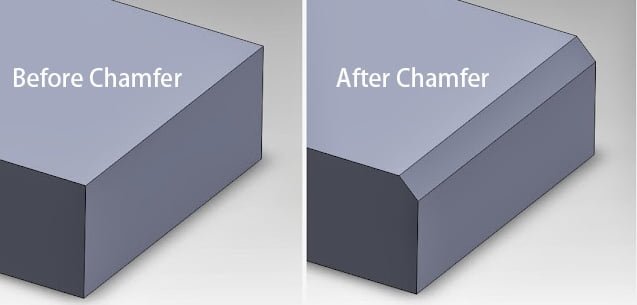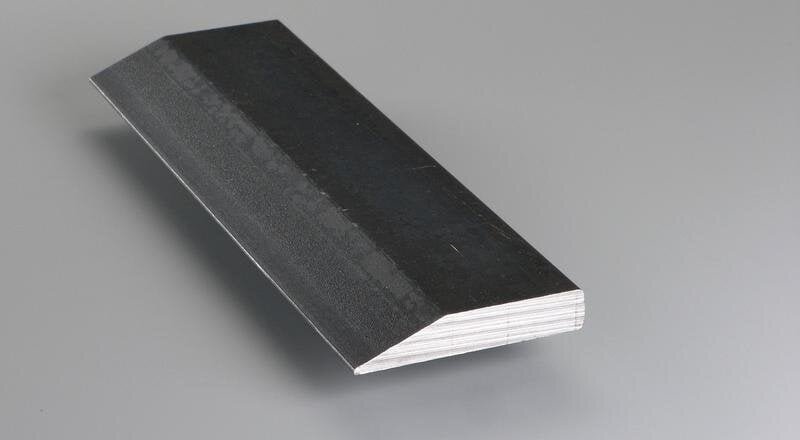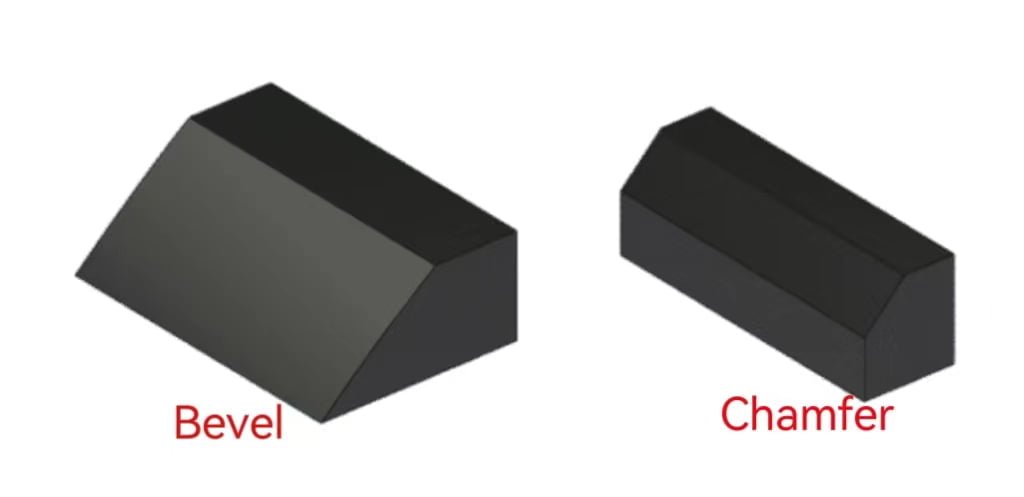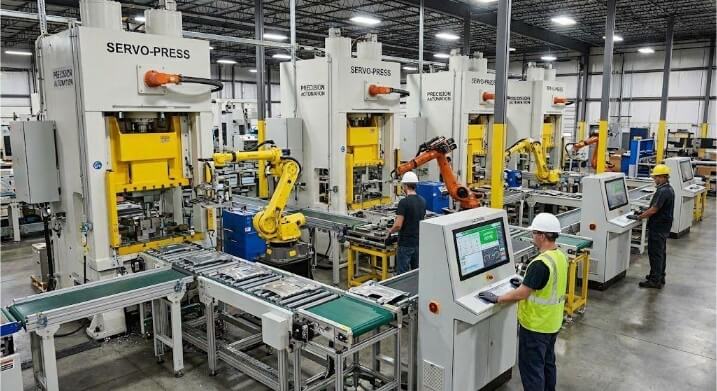When designing parts or products, you might come across terms like “chamfer” and “bevel.” Though they may seem similar, they serve different manufacturing and product design purposes. Knowing the difference is key to making the right choice for your projects.
Chamfer and bevel refer to angled cuts on the edges of materials, but there are key differences. A chamfer is typically a straight cut at a 45-degree angle, often used to remove sharp edges and improve safety or aesthetics. Conversely, a bevel can be any angle other than 90 degrees, offering more versatility for various design needs.
Understanding how these terms differ can help you choose your product’s edge treatment. Let’s explore what each one means in detail and when to use them.
What is a Chamfer?
A chamfer is a cut along the edge of a part that removes the sharp corner by creating a flat surface at an angle. The most common chamfer angle is 45 degrees, depending on the application. This technique is used for functional and aesthetic reasons, such as making it easier to assemble parts or reducing the chance of a sharp edge causing injury.
Chamfers are often used in engineering designs to facilitate assembly and ensure that parts fit together more smoothly. They can also be applied to materials like metal or plastic to help avoid sharp edges that could cause damage or wear over time.
Key Features of a Chamfer
- Flat Surface: A chamfer creates a flat, angled surface along the edge.
- Standard Angles: Typically cut at 45 degrees, but other angles are possible.
- Purpose: Often used to remove sharp edges, reduce stress concentrations, or make assembly easier.
Applications of Chamfers
- Safety: Chamfers remove sharp edges, reducing the risk of injury.
- Aesthetics: They give a polished, professional look to parts.
- Functionality: Chamfers help parts fit together smoothly during assembly.

What is a Bevel?
A bevel is an angled cut that connects two surfaces. In terms of the angles they can accommodate, bevels are more flexible than chamfers. For example, depending on the project needs, a bevel might have a 30-degree, 45-degree, or even 60-degree angle, .
Bevels are commonly used in machining, construction, and metal fabrication, where a specific edge angle is required for function or aesthetic appeal. They can help improve the fit of parts, reduce stress on joints, and enhance the product’s overall appearance.
Key Features of a Bevel
- Angled Edge: A bevel creates an angled surface that connects two planes.
- Standard Angles: Often cut at 45 degrees but vary depending on the application.
- Purpose: Used to join materials, improve strength, or prepare edges for welding.
Applications of Bevels
- Welding: Beveled edges provide better penetration and stronger welds.
- Joining Materials: They help create smooth transitions between surfaces.
- Structural Integrity: Bevels reduce stress concentrations in critical areas.

Key Differences Between Chamfer and Bevel
Understanding the difference between chamfers and bevels is essential when designing and manufacturing parts. These terms refer to angled cuts but differ in several ways. Let’s break down their main differences.
Geometrical Differences
Angle Specifications
A chamfer is usually cut at a 45-degree angle, though other angles can be used. The angle is generally the same along the entire edge.
In contrast, a bevel can be cut at any angle other than 90 degrees, allowing for more flexibility in design.
Edge Types
Chamfers create a flat surface on the edge, typically to remove sharp corners. This makes the part safer and easier to handle.
Bevels also create an angled edge, but they are often used to develop sloped surfaces, which can have structural and aesthetic purposes.
Machining Method
Chamfers are simpler to machine and faster to produce. They can be made easily with standard CNC machines, and the 45-degree angle used for most chamfers makes them quick to set up.
Bevels might require more setup, especially if the angle is not standard. More tools or adjustments might be needed to achieve the desired level.
Method of Measurement
The cut’s angle and length along the edge often measure chamfers. For example, the cut might be a 45-degree angle and extend a certain distance from the corner.
Bevels are usually measured by the angle of the cut itself, like 30, 45, or 60 degrees. The length of the bevel can vary, but the main focus is the angle.
Aesthetic and Functional Impacts
Functionally, chamfers are often used to remove sharp edges, making the part easier to assemble or safer to handle. They are also helpful in improving the fit of parts. On the other hand, Bevels can help with the strength or assembly of parts by creating a specific angle.
Both chamfers and bevels can improve a design’s aesthetics. Bevels offer more variety in angles, allowing for more customization in the final appearance.
Chamfer vs Bevel: How to Identify
Identifying whether a cut is a chamfer or a bevel is straightforward once you know what to look for. Let’s break it down.
Chamfer
A chamfer is easy to spot if you know its key characteristics:
- Flat Edge: A chamfer creates a flat, sloping surface along the edge of a material.
- Standard Angle: It’s usually cut at a 45-degree angle, but other angles are possible.
- Purpose: Look for chamfers on parts with sharp edges removed for safety, aesthetics, or easier assembly.
Example: If you see a metal plate with corners cut off at a 45-degree angle, that’s a chamfer.
Bevel
A bevel has distinct features that set it apart from a chamfer:
- Angled Surface: A bevel creates an angled surface that connects two planes, often at a 45-degree angle.
- Purpose: Bevels are commonly found on edges that need to be joined, welded, or require a smooth transition.
Example: If you see a steel plate with one edge cut at an angle to prepare it for welding, that’s a bevel.
Focusing on the shape and purpose of the cut can easily tell whether you’re looking at a chamfer or a bevel. Chamfers are flat and used for safety or assembly, while bevels are angled and used for joining or welding.

Chamfer vs Bevel:Pros and Cons
Both chamfers and bevels have their advantages and disadvantages. Understanding these can help you decide which one to use for your project.
Chamfer
Pros
- Safety: Removes sharp edges, reducing the risk of injury.
- Aesthetics: Gives a clean, polished look to parts.
- Ease of Assembly: Helps parts fit together more smoothly.
- Cost-Effective: Simple to machine and requires less precision than bevels.
Cons
- Limited Strength: Not ideal for structural applications where strong joints are needed.
- Less Functional for Welding: It doesn’t provide the same weld penetration as a bevel.
Bevel
Pros
- Strong Joints: Ideal for welding, as it allows for better penetration and stronger connections.
- Structural Integrity: Reduces stress concentrations in critical areas.
- Smooth Transitions: Creates seamless connections between materials.
Cons
- More Complex: More precision and specialized tools are required for the machine.
- Higher Cost: This can be more expensive due to the additional machining effort.
- Not Always Needed: Overkill for simple applications where a chamfer would suffice.
Choosing Between Chamfer and Bevel
Whether you use a chamfer or a bevel depends on your project’s specific needs. Here’s a guide to help you make the right choice.
Key Considerations for Designers
When choosing between a chamfer and a bevel, consider the following factors:
- Functionality: What is the primary purpose of the cut? Is it for safety, assembly, or structural strength?
- Aesthetics: Does the part need a polished look or a seamless transition?
- Cost: How much time and resources are you willing to invest in machining?
- Material: Some materials may respond better to one type of cut.
When to Use Chamfering
Use a chamfer in the following scenarios:
- Safety: To remove sharp edges and reduce the risk of injury.
- Aesthetics: To give parts a clean, finished appearance.
- Assembly: To make it easier for parts to fit together during assembly.
- Cost-Effective Solutions: When you need a simple, quick modification without complex machining.
Example: Adding a chamfer to the edges of a metal bracket makes it safer to handle and easier to install.
When to Use Beveling
Use a bevel in the following scenarios:
- Welding Preparation: To create strong, reliable welds with better penetration.
- Structural Integrity: To reduce stress concentrations and improve the strength of joints.
- Seamless Transitions: To create smooth connections between two surfaces.
- Complex Designs: When the project requires precise, angled cuts for functional or aesthetic reasons.
Example: Beveling the edges of steel plates before welding to ensure a strong, durable joint.
Conclusion
Chamfers and bevels are both angled cuts used in manufacturing but differ in purpose, design, and application. When choosing between them, consider design flexibility, manufacturing complexity, and the part’s purpose.
If you’re unsure which edge treatment is right for your project, contact our experts today for advice. We can help you find the best solution that meets your design and production needs. Contact us now to get started on your next project!
More Resources:
Beveling for welding strength – Source: Medium
Chamfering in metal fabrication – Source: Protolabs
Best Tips & Tricks On Beveling – Source: SAAR USA
Hey, I'm Kevin Lee

For the past 10 years, I’ve been immersed in various forms of sheet metal fabrication, sharing cool insights here from my experiences across diverse workshops.
Get in touch

Kevin Lee
I have over ten years of professional experience in sheet metal fabrication, specializing in laser cutting, bending, welding, and surface treatment techniques. As the Technical Director at Shengen, I am committed to solving complex manufacturing challenges and driving innovation and quality in each project.




